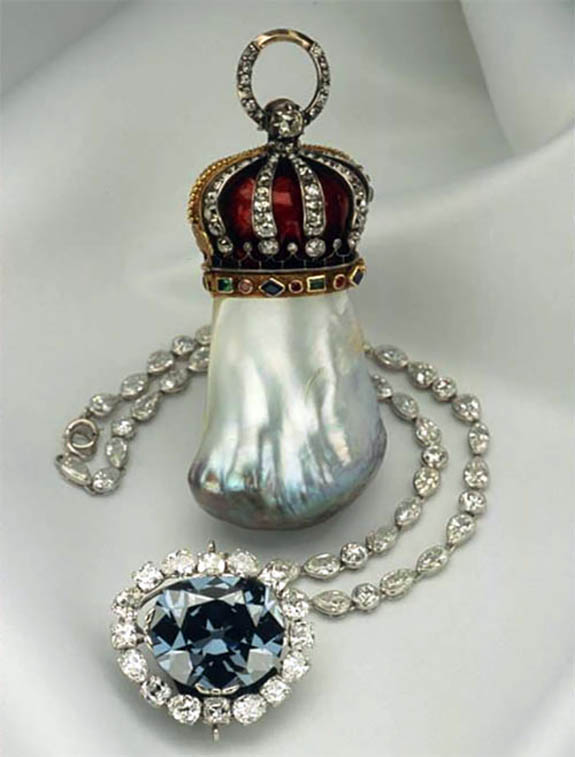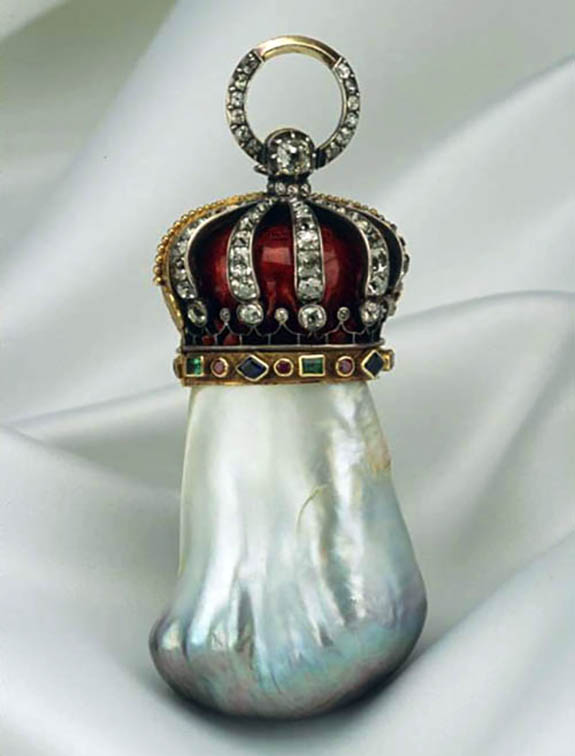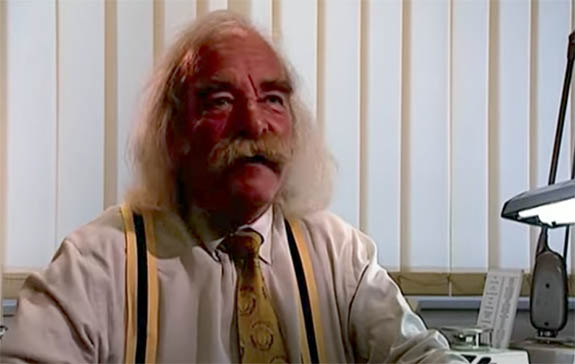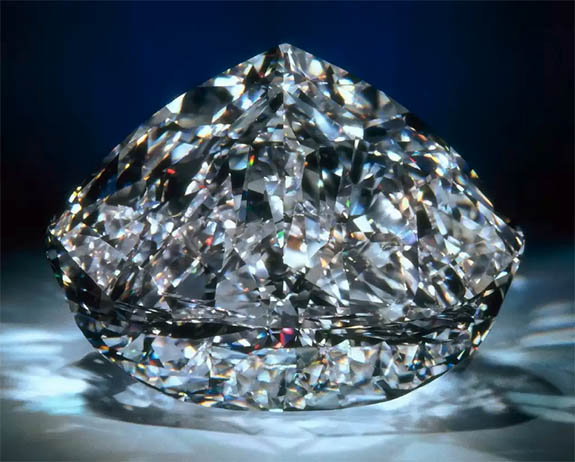June 1st, 2023
Let’s celebrate June’s official birthstone with a deep dive into the backstory of one of the most celebrated natural pearls in the world — the Hope Pearl — and its famous sibling, the Hope Diamond.

How these two museum-quality pieces were reunited after 156 years apart is a heartwarming and intriguing tale. Read on…
Back in the early part of the 19th century, a London banker named Henry Philip Hope amassed a collection of fabulous gems, including the deep blue 45.52-carat Hope Diamond and 150 extraordinarily rare natural pearls.

Hope’s namesake pearl, which was once believed to be the largest natural saltwater baroque pearl in existence, is set as a pendant, with the narrower end capped with a crown of red enameled gold set with diamonds, rubies and emeralds. The pearl stands two inches tall and weighs 450 carats.
It exhibits an irregular pear shape and a unique coloration, grading from dark bronze to white. Experts believe the baroque specimen is a blister pearl, which grows attached to the mollusk’s shell.
Both the Hope Diamond (purchased in 1824) and Hope Pearl (purchased between 1800 and 1810) were mentioned prominently in the 1839 publication titled “Catalogue of the Collection of Pearls and Precious Stones Formed by Henry Philip Hope, Esq.”
Hope, who never married, died that same year at the age of 65.
A bitter legal battle ensued among his three nephews. Each of them made claims on the estate, and after 10 years, a settlement was reached and the jewels were split up. The pearl ended up in the South Kensington Museum for many years, and was sold at a Christie’s auction in 1886 for £9,000 (about £950,000, or $1.18 million, in today’s valuation).
The Hope Diamond and Hope Pearl remained apart for the next 156 years. But then, in 2005, the diamond and pearl siblings enjoyed a momentous six-month reunion at the Smithsonian in Washington, DC. The Hope Diamond was already a resident of the National Gem and Mineral collection at the National Museum of Natural History.
The Hope Pearl was one of 12 extraordinary specimens featured in a special exhibition called “The Allure of Pearls” in the Harry Winston Gallery of the Janet Annenberg Hooker Hall of Geology, Gems and Minerals. The Hope Pearl was loaned for the presentation by an unnamed collector from England.
Other specimens in the exhibition included La Peregrina, the Pearl of Asia, the Drexel Pearl, the Black Beauty, the Pearl of Kuwait, the Queen Mary Brooch with two large natural pink conch pearls, the South Sea Drops, the Survival Pearl and the Paspaley Pearl.
A natural pearl is extraordinarily rare and valuable because it is formed inside a mollusk totally by chance, without human intervention. A natural pearl forms when an irritant, such as a grain of sand, slips between the mollusk’s shell and its mantle tissue.
To protect itself from the irritant, the mollusk secretes layer upon layer of nacre, which is the iridescent material that eventually produces a pearl. Cultured pearls, by comparison, are grown under controlled conditions, where a bead is implanted in the body of the mollusk to stimulate the secretion of nacre.
Pearl is one of the three official birthstones for June. The others are alexandrite and moonstone.
Credits: Smithsonian/NMNH Photo Services.

How these two museum-quality pieces were reunited after 156 years apart is a heartwarming and intriguing tale. Read on…
Back in the early part of the 19th century, a London banker named Henry Philip Hope amassed a collection of fabulous gems, including the deep blue 45.52-carat Hope Diamond and 150 extraordinarily rare natural pearls.

Hope’s namesake pearl, which was once believed to be the largest natural saltwater baroque pearl in existence, is set as a pendant, with the narrower end capped with a crown of red enameled gold set with diamonds, rubies and emeralds. The pearl stands two inches tall and weighs 450 carats.
It exhibits an irregular pear shape and a unique coloration, grading from dark bronze to white. Experts believe the baroque specimen is a blister pearl, which grows attached to the mollusk’s shell.
Both the Hope Diamond (purchased in 1824) and Hope Pearl (purchased between 1800 and 1810) were mentioned prominently in the 1839 publication titled “Catalogue of the Collection of Pearls and Precious Stones Formed by Henry Philip Hope, Esq.”
Hope, who never married, died that same year at the age of 65.
A bitter legal battle ensued among his three nephews. Each of them made claims on the estate, and after 10 years, a settlement was reached and the jewels were split up. The pearl ended up in the South Kensington Museum for many years, and was sold at a Christie’s auction in 1886 for £9,000 (about £950,000, or $1.18 million, in today’s valuation).
The Hope Diamond and Hope Pearl remained apart for the next 156 years. But then, in 2005, the diamond and pearl siblings enjoyed a momentous six-month reunion at the Smithsonian in Washington, DC. The Hope Diamond was already a resident of the National Gem and Mineral collection at the National Museum of Natural History.
The Hope Pearl was one of 12 extraordinary specimens featured in a special exhibition called “The Allure of Pearls” in the Harry Winston Gallery of the Janet Annenberg Hooker Hall of Geology, Gems and Minerals. The Hope Pearl was loaned for the presentation by an unnamed collector from England.
Other specimens in the exhibition included La Peregrina, the Pearl of Asia, the Drexel Pearl, the Black Beauty, the Pearl of Kuwait, the Queen Mary Brooch with two large natural pink conch pearls, the South Sea Drops, the Survival Pearl and the Paspaley Pearl.
A natural pearl is extraordinarily rare and valuable because it is formed inside a mollusk totally by chance, without human intervention. A natural pearl forms when an irritant, such as a grain of sand, slips between the mollusk’s shell and its mantle tissue.
To protect itself from the irritant, the mollusk secretes layer upon layer of nacre, which is the iridescent material that eventually produces a pearl. Cultured pearls, by comparison, are grown under controlled conditions, where a bead is implanted in the body of the mollusk to stimulate the secretion of nacre.
Pearl is one of the three official birthstones for June. The others are alexandrite and moonstone.
Credits: Smithsonian/NMNH Photo Services.




